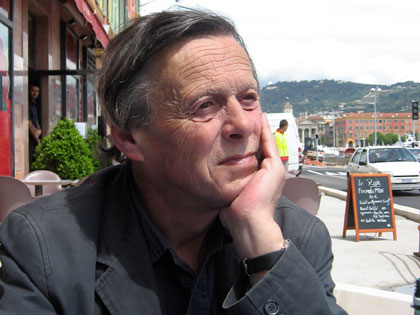Irish Independent, March 23, 2013
Nineteen artistic worthies were summoned to the Aras for Glaoch: The President’s Call (RTE1), which left me pondering why nineteen equally worthy others hadn’t been given the nod.
Seamus Heaney was there, of course, as well as Paula Meehan, the latter gazing out a window and soulfully declaiming a poem that seemed to go on for ever, but where was Paul Muldoon or Paul Durcan? Maybe Michael D doesn’t care for their stuff, though you’d imagine Muldoon’s manic wordplay and Durcan’s declamatory style would be right up his street.
And what does he think of John Banville, Anne Enright and Colm Toibin? They weren’t there, either, though Joseph O’Connor was among the invitees and gave his characteristic singsong delivery to something that sounded like free verse but might just as easily have been a script deemed too airy-fairy for Mary Wilson’s Drivetime.
The President chatted to some of his favoured guests, though chat is probably not the right word to describe quite a few of the conversations, which were positively solemn in their earnestness and occasionally ascended/descended (take your pick) into semi-mystical waffle.
They were at their most intense when Michael D and playwright Tom Murphy grappled with notions of small-town silence and longing, when Peadar O Riada assured his host that “we venerate creativity in our culture”, and when Louis de Paor opined that “our dreams may yet become us”. Probably unfairly, I expected the same sort of guff from Bono, but he chose to be unpretentious and down-to-earth instead.
So what was the film about? Search me, but at the fag-end of the St Patrick’s weekend and with The Gathering plainly on its mind, it seemed to be aiming at some kind of woozy celebration of Irishness and the wonders of the Irish imagination. Or as Michael D phrased it in the closing moments: “It’s as if the wide space of the culture has the possibility to transform everything” and that the result of this alchemical process is “an Irishness we can be proud of”.
Faith and begorrah, we’re an extraordinary people, but don’t take our President’s word for it – Northern Irish actor James Nesbitt thinks so, too, as I learned from the opening instalment of James Nesbitt’s Ireland (UTV).
“Stunning” and “magical” were James’s favourite words as he introduced “a guided tour of some of the most stunning sights, sounds and tastes that have made this country famous the world over”. Among the sights were “a thousand miles of stunning coastline” and “stunning ancestral homes”, some of them located in the “magical southwest” which was a “magical place to visit”.
In particular, James visited two Americans brothers who manufacture ice cream in Dingle and a couple who manufacture holidays for guests at their country mansion in Cork and the programme ended up being a shameless puff for both of these enterprises. Meanwhile, James extolled “the warmth of the Irish people” and uttered various other threadbare cliches of the same ilk.
No doubt Failte Ireland loved James’s take on the ould sod but it probably but wouldn’t be too happy with In the Name of the Republic (TV3), a two-part series intent on reminding us of the murderous cruelties committed in the cause of Irish republicanism.
The presenter is TCD history professor Eunan O’Halpin, who himself is the product of a violently republican past and who grew up listening to family reminiscences about IRA involvement. His aim here, though, is to document “the fate of civilians killed by the IRA” between 1919 and 1923 and in this week’s opening instalment he focused on a number of cases of the “disappeared”.
However, too much of the film’s time was spent in a Co Laois field where it was alleged that had least two men killed by the IRA during the Civil War had been buried. An excavation by a specialist firm was conducted but after much searching only an animal’s bones were unearthed, leading the presenter to announce that “naturally we were all disappointed at not finding human remains”.
Not half as disappointed, however, as the viewer, who felt his time had been wasted with prolonged footage that amounted to nothing. Still, the film had virtues, too, not least the dramatic reconstructions featuring Don Wycherly as early Sinn Fein supporter Patrick Sarsfield O’Hegarty, who in a 1923 book denounced the IRA’s savage murders of police and civilians as “beastly things” by “moral degenerates”.
There’ll probably be even beastlier things in next week’s instalment, which will focus most of its attention on notorious IRA activities in Cork between 1919 and the end of the Civil War. TV3 is to be commended for commissioning the series.
Kevin Eldon, stalwart of such cult comedy shows as Brass Eye and Big Train, gets his own series with It’s Kevin (BBC2). The first episode had its moments, the best being a sketch in which Adolf Hitler reminisced in the voice and manner of Beatles sage George Martin. “Me and the boys”, he fondly recalled, “marched into Poland and I immediately knew we were onto something big”.
The Lady Vanishes (BBC1) was a pointless version of the original Ethel Lina White novel, thus omitting all the wonderful little innovations that Alfred Hitchcock brought to his great 1938 version. So it had no forebodings about Munich and, crucially, no Charters and Caldicott obsessing about cricket. They should have left it alone.
Panel
William Hurt was the best reason for watching The Challenger (BBC2), but then this underused actor is the usually the best thing about the movies he chooses to grace.
Here he brought his customary intelligence and alertness to the role of Nobel physicist Richard Feynman, who was recruited to an official 1986 committee tasked with finding out why that year’s space shuttle exploded just after takeoff.
The film was overly hagiographic but Hurt was very persuasive in his scorn for vested interests and his search for the truth.
